Unpublished Data Show High Concentrations of Iodine-132 in Foods after the Nuclear Accident—Fukushima Prefecture
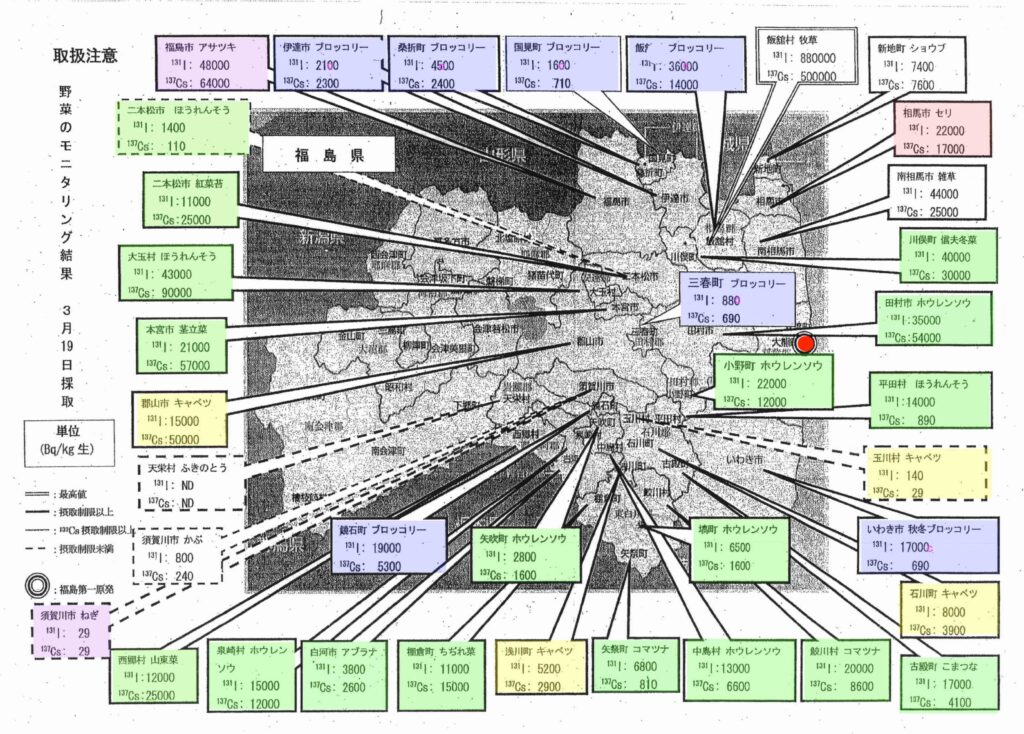
OurPlanet-TV has obtained unpublished food data of Fukushima Prefecture from March 19, 2011, following the accident at Tokyo Electric Power Co.’s Fukushima Daiichi Nuclear Power Station. According to these data, 48,000 becquerels per kilogram (bq/kg) of radioactive iodine-131 (I-131) had been detected in chives in Fukushima City. In addition, high levels of both cesium-134 (Cs-134) and Cs-137 were also measured, at 64,000 bq/kg each. Also not mentioned until now was that I-132 levels even higher than those of I-131 were recorded, at 76,000 bq/kg.
These data consist of measurements taken by the Fukushima prefectural government on March 19, 2011 for 37 environmental samples that included vegetables from farmers in 34 cities, towns, and villages in the prefecture after the national government had announced provisional regulation values for foods on March 17. However, since the samples had been collected based on “Method for Sampling of Environmental Materials in Emergencies,” which had been sent out by Japan Chemical Analysis Center (JCAC), rather than the Ministry of Health, Labour and Welfare’s (MHLW’s) manual for radioactive measurements of foodstuffs in emergencies, the data were never released but kept stored away for ten years.
Concentrations of Radioactive Substances Detected Exceeding Those of Designated Wastes
According to the data, an absurdly high level of 880,000 bq/kg of radioactive I-131 was measured in pasture grasses in Iitate Village; and in spinach from Otama Village, levels of 43,000 bq/kg of I-131, 73,000 bq/kg of I-132, 89,000 bq/kg of Cs-137, and 90,000 bq/kg of Cs-134 were recorded. These readings vastly exceed the reference value of 8,000 bq/kg or more for designated radioactive waste requiring special disposal methods.
The provisional regulation values on foods released on March 17, 2011 by MHLW showed 2,000 bq/kg for radioactive iodine and 500 bq/kg for cesium, but in 34 of the 37 samples, contamination exceeding these provisional values was measured. Correction for radioactive decay was not done for these figures, so it appears the levels had been even higher when the samples were collected.
| Municipality | Sample name | Sample No. | I131 | I132 | Cs134 | Cs136 | Unit | |
| 1 | Shinchi | Iris | V58 | 7400±80 | 16000±100 | 7800±100 | 7700±100 | Bq/kg wet weight |
| 2 | Soma | celery | V8 | 22000±100 | 33000±100 | 16000±100 | 17000±100 | Bq/kg wet weight |
| 3 | Minamisoma | weed | V11 | 44000±100 | 48000±200 | 24000±200 | 25000±100 | Bq/kg wet weight |
| 4 | Iitate | grass | V53-1 | 880000±3000 | 890000±3000 | 520000±100 | 500000±3000 | Bq/kg wet weight |
| 4 | Iitate | Broccoli | V53-2 | 36000±20 | 25000±200 | 14000±200 | 14000±200 | Bq/kg wet weight |
| 6 | Iwaki | Fall/winter broccoli (open field) | V4 | 17000±70 | 1800±500 | 770±23 | 690±20 | Bq/kg wet weight |
| 7 | Fukushima | Japanese chives | V1 | 4800±4000 | 76000±500 | 64000±600 | 64000±500 | Bq/kg wet weight |
| 8 | Date | Broccoli | V12 | 2100±30 | 4100±40 | 2300±40 | 2300±40 | Bq/kg wet weight |
| 9 | Kinimi | Broccoli | V15 | 1600±100 | 1400±20 | 670±19 | 710±17 | Bq/kg wet weight |
| 10 | Kori | Broccoli | V14 | 4500±20 | 4900±100 | 2500±40 | 2400±100 | Bq/kg wet weight |
| 11 | Nihonmatsu | Red spinach moss | V9-1 | 11000±70 | 29000±100 | 25000±100 | 25000±40 | Bq/kg wet weight |
| 12 | Nihonmatsu | Spinach | V9-2 | 1400±200 | 190±8 | 100±8 | 110±7 | Bq/kg wet weight |
| 13 | Otama | Spinach | V17 | 43000±100 | 73000±100 | 89000±200 | 90000±200 | Bq/kg wet weight |
| 13 | Tamura | Spinach | V10 | 3500±3000 | 45000±300 | 52000±400 | 54000±400 | Bq/kg wet weight |
| 14 | Ono | spinach | V49-1 | 22000±70 | 12000±60 | 12000±80 | 12000±70 | Bq/kg wet weight |
| 14 | Motomiya | Tachibana stem | V13-1 | 21000±100 | 55000±200 | 57000±200 | 57000±200 | Bq/kg wet weight |
| 15 | Koriyama | cabbage | V3-1 | 15000±200 | 49000±400 | 49000±500 | 5000±400 | Bq/kg wet weight |
| 16 | Miharu | Broccoli^. | V48 | 880±18 | 880±20 | 690±22 | 690±20 | Bq/kg wet weight |
| 19 | Sukagawa | turnip (Brassica rapa) | V6-1 | 800±15 | 470±14 | 210±11 | 2400±11 | Bq/kg wet weight |
| 20 | Sukagawa | green onion | V6-2 | 29±3.8 | 43±4.4 | 29±4.8 | 29±4.1 | Bq/kg wet weight |
| 21 | Hirata | Spinach | V45 | 14000±60 | 990±21 | 890±24 | 890±22 | Bq/kg wet weight |
| 22 | Tamagawa | cabbage | V44 | 140±7 | 43±4.9 | 33±5.0 | 29±4.2 | Bq/kg wet weight |
| 23 | Kagamiishi | Broccoli | V18 | 19000±80 | 7200±60 | 5400±60 | 5300±50 | Bq/kg wet weight |
| 24 | Furudono | komatsuna | V27 | 17000±100 | 5100±40 | 4000±40 | 4100±40 | Bq/kg wet weight |
| 25 | Idhikawa | cabbage | V43 | 8000±50 | 5200±50 | 3700±50 | 3900±50 | Bq/kg wet weight |
| 26 | Tenei | butterbur sprouts | V19 | * * | * * | * * | * * | Bq/kg wet weight |
| 27 | Yabuki | Spinach (open field) | V38 | 2800±30 | 1600±30 | 1600±30 | 1600±30 | Bq/kg wet weight |
| 28 | Nakajima | Spinach (open field) | V37 | 13000±50 | 8900±50 | 6400±50 | 6600±50 | Bq/kg wet weight |
| 29 | Izumizaki | Spinach (open field) | V36 | 15000±90 | 20000±100 | 12000±100 | 12000±100 | Bq/kg wet weight |
| 30 | Saigo | santong rape | V35 | 12000±60 | 27000±100 | 25000±100 | 25000±100 | Bq/Kg生 |
| 31 | Shirakawa | Oilseed rape (open field) | V5 | 3800±40 | 3100±40 | 2700±50 | 2600±40 | Bq/kg wet weight |
| 32 | Tanakura | chinkapin | V39 | 11000±70 | 16000±90 | 15000±100 | 15000±100 | Bq/kg wet weight |
| 33 | Asakawa | cabbage | V46 | 5200±50 | 3900±40 | 2900±50 | 2900±40 | Bq/kg wet weight |
| 34 | Samegawa | Komatsuna | V42 | 20000±80 | 9200±60 | 8600±40 | 8600±40 | Bq/kg wet weight |
| 35 | Haniwa | Spinach | V41 | 6500±50 | 2000±30 | 1800±40 | 1600±30 | Bq/kg wet weight |
| 36 | Ymatsuri | Komatsuna | V40 | 6800±40 | 1200±20 | 800±22 | 810±20 | Bq/kg wet weight |
| 37 | Kawamata | Nobuo winter greens | 40000±200 | 74000±300 | 29000±200 | 30000±200 | Bq/kg wet weight | |
| Municipality | Sample name | Sample No. | I131 | I132 | Cs134 | Cs136 | unit |
government the next day, on March 20.
Higher Levels of I-132 Detected than of I-131
What stands out among the data are the figures for I-132. In 16 of the 37 samples—more than 40%—the figures for I-132 exceed those of I-131.
Iodine-132 is a daughter species produced by the beta-decay of tellurium-132 (Te-132). The former has a brief half-life of only 2.3 hours, but due to its relationship with the radioactive equilibrium of Te-132, which has a half-life of 3.2 days, it behaves similarly to the latter.
There are many questions remaining even now about the situation regarding the diffusion of short-lived radionuclides following the nuclear accident in Fukushima, but in a thesis titled “Estimation of Xe-135, I-131, I-132, I-133 and Te-132 Concentrations in Plumes at Monitoring Posts in Fukushima Prefecture Using Pulse Height Distribution Obtained from Nal(Tl) Detector,” authored by researchers at the High Energy Accelerator Research Organization (also known as “KEK”) in 2017, the radioactive plume that spread on March 13 to 15 contained a high percentage of Te-132 and contributed 70% or more of the Te-132 reaching Fukushima City and Hirono Town. Their report is in agreement with the environmental sample data being presented here.
On the other hand, in the United Nations Scientific Committee on the Effects of Atomic Radiation (UNSCEAR) 2020 Report, which was released in March 2021, the impact of short-lived radionuclides, i.e., Te-132 and I-132, from radioactive plume that spread on March 15 to 16 was small, but that would need future verification.
Distribution of Vegetables Grown in Fukushima Prefecture Continued
In addition, according to the “Shikyo (Market Trend)” reports on wholesale market conditions in Fukushima Prefecture obtained and spoken statements gathered by OurPlanet-TV, the vegetables of concern were still being distributed after the accident until at least March 22. Moreover, despite high levels of contamination detected in chives from Fukushima City, MHLW failed to restrict distribution of Chinese chives (nira), a vegetable of the same genus as onions and garlic, because the targets for restricted consumption were limited to non-heading leafy vegetables, heading leafy vegetables, and flowerhead brassicas from Fukushima Prefecture. Because of that, Chinese chives continued to be marketed, though most of these had been cultivated in greenhouses.
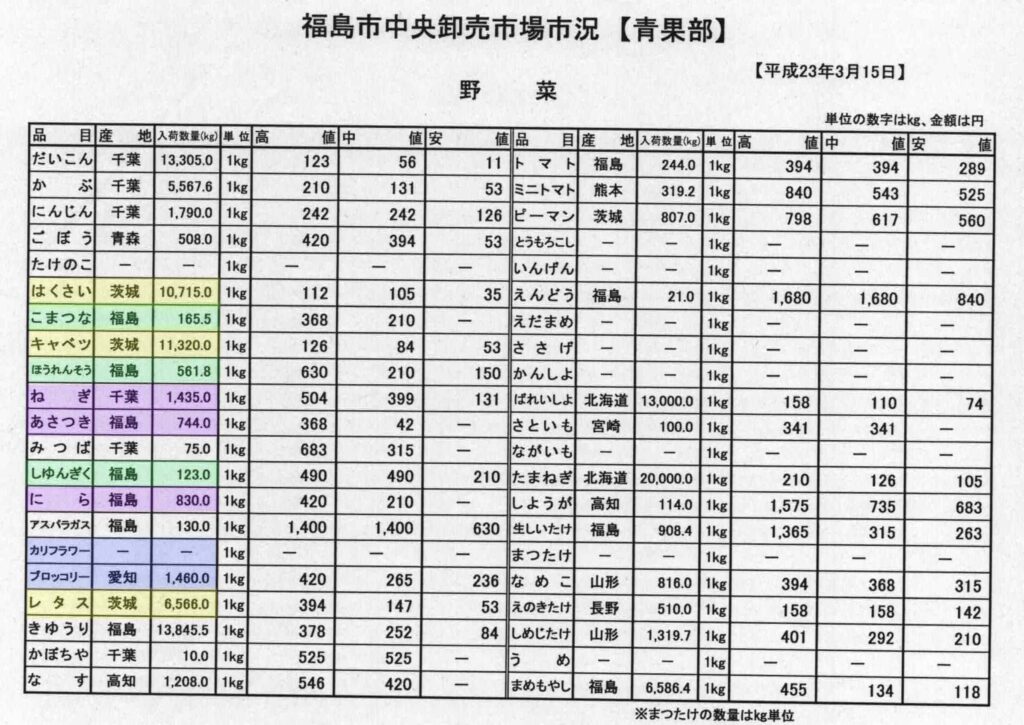
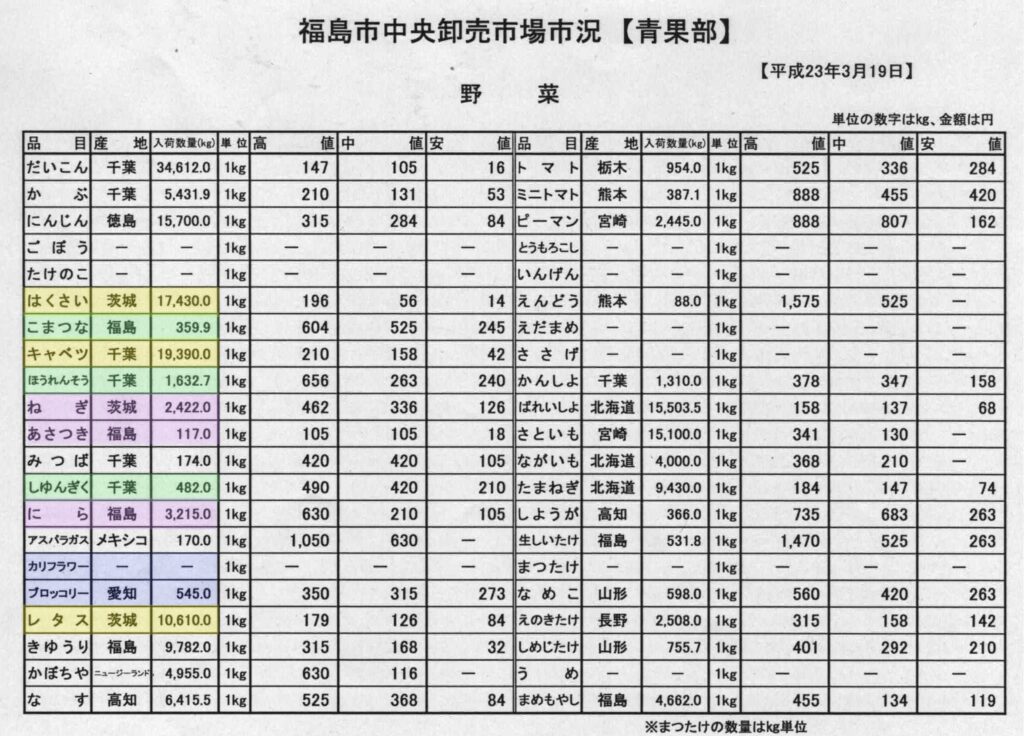
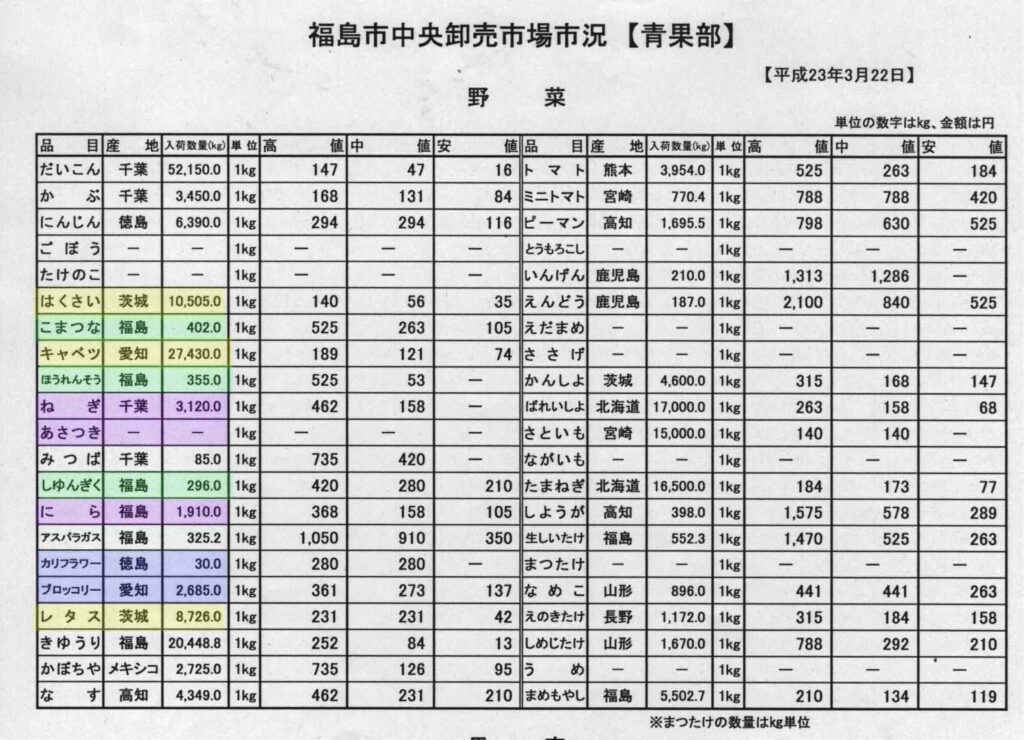
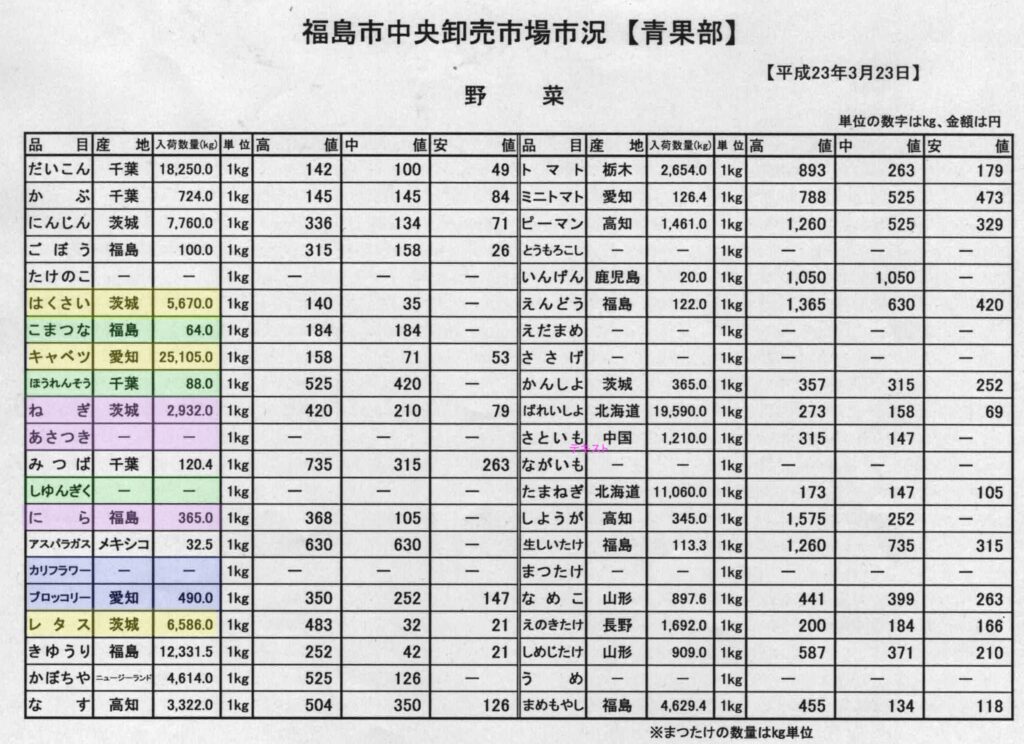
Vegetables with Distribution Restricted by MLHW
| Non-heading Leafy Vegetables Spinach, Japanese mustard spinach, spider mustard(mizuna), pak choy, edible rapeseed(nabana or kakina), non-heading lettuce (romaine lettuce, sunny lettuce, etc.), crown daisy, kukitachina, shinobuna, santona, turnip rape, chijirena, purple-stem mustard(kosaitai), urui, field wasabi, flower wasabi, water cress, garden rocket, shepherd’s purse, petit-vert, ice plant, leaf daikon, and others |
| Heading Leafy Vegetables Cabbage, napa cabbage, heading lettuce, and others |
| Flowerhead Brassicas Broccoli, cauliflower, and others |
Vegetables with Distribution Not Restricted by MLHW
| Allium Vegetables Green onions, Chinese chives, spring onions, garlic greens, chives, and others |
“Method for Sampling of Environmental Materials in Emergencies” differs from the MHLW manual for radioactive measurements of foodstuffs in emergencies in that the former says measurements are to be taken of the collected samples as they are, while the latter says they are to be rinsed with water and measurements taken of only the edible portions. According to a report (in Japanese) compiled by the Japanese Society of Radiation Safety Management in May 2011, it is more difficult to remove radioactive iodine than other radioactive nuclides such as cesium. Moreover, at that time the contamination of leaf surfaces was higher than that of stems and roots. In addition, it has been said that radiation from cesium was higher in plants than in the soil. Particulars on the environmental sample measurement conditions and distribution of foods at that time are detailed in the September 2021 issue of Kagaku, published by Iwanami Shoten, which was released on August 25 (in Japanese). Please refer to that.







